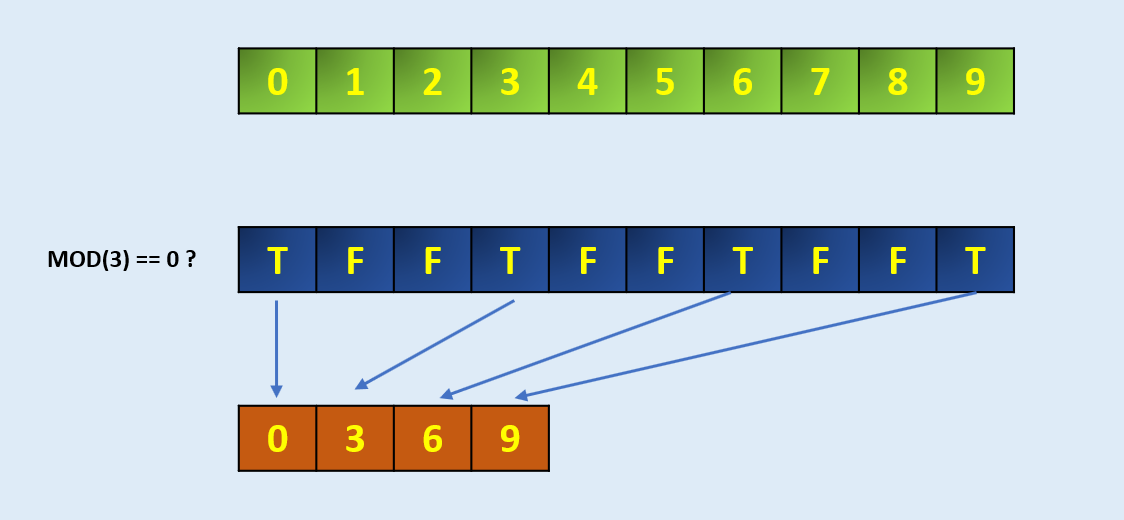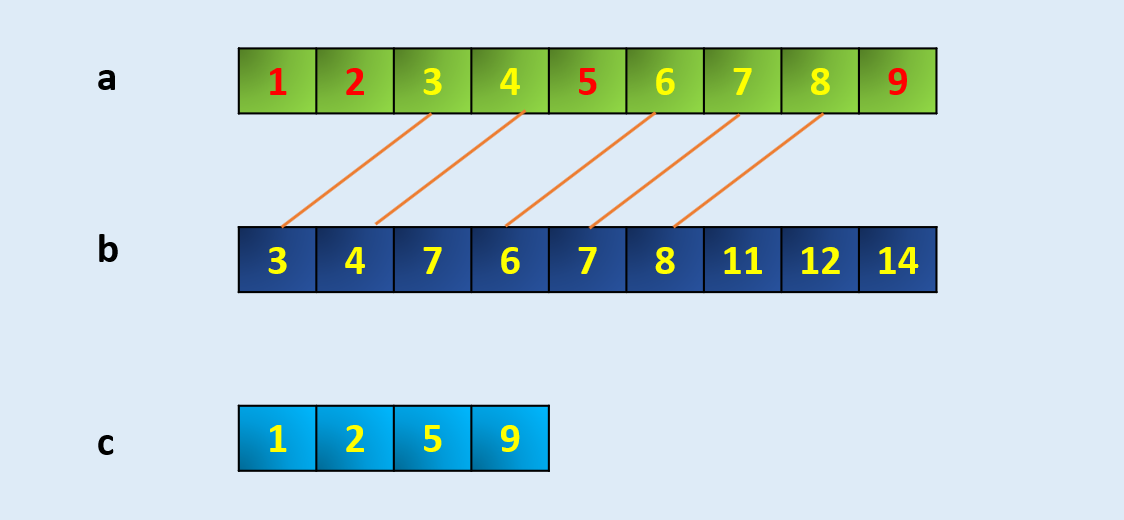Useful NumPy functions: Reshape, Argpartition, Clip, Extract, Setdiff1d
In everyday data processing for Machine Learning and Data Science projects, we encounter unique situations, those require boilerplate code to solve the problem. Over the period some of those are converted into base features provided by the core language or the package itself as per need and usage from the community. Here I am sharing 5 elegant python Numpy functions, which can be used for efficient and neat data manipulation.
1) Use of -1 in Reshape
Numpy allows us to reshape a matrix provided new shape should be compatible with the original shape. One interesting aspect of this new shape is, we can give one of the shape parameter as -1. It simply means that it is an unknown dimension and we want Numpy to figure it out. Numpy will figure this by looking at the ‘length of the array and remaining dimensions’ and making sure it satisfies the above mentioned criteria. Let's see one example now.

Pictorial representation of different reshape with one dimension as -1
a = np.array([[1, 2, 3, 4],
[5, 6, 7, 8]])
a.shape
(2, 4)
Suppose we give row as 1 and -1 as column then Numpy will able to find column as 8.
a.reshape(1,-1)
array([[1, 2, 3, 4, 5, 6, 7, 8]])
Suppose we give row as -1 and 1 as column then Numpy will able to find row as 8.
a.reshape(-1,1)
array([[1],
[2],
[3],
[4],
[5],
[6],
[7],
[8]])
Similarly below are possible.
a.reshape(-1,4)
array([[1, 2, 3, 4],
[5, 6, 7, 8]])a.reshape(-1,2)
array([[1, 2],
[3, 4],
[5, 6],
[7, 8]])a.reshape(2,-1)
array([[1, 2, 3, 4],
[5, 6, 7, 8]])a.reshape(4,-1)
array([[1, 2],
[3, 4],
[5, 6],
[7, 8]])
This is also applicable to any higher level tensor reshape as well but only one dimension can be given -1.
a.reshape(2,2,-1)
array([[[1, 2],
[3, 4]], [[5, 6],
[7, 8]]])a.reshape(2,-1,1)
array([[[1],
[2],
[3],
[4]], [[5],
[6],
[7],
[8]]])
If we try to reshape a non-compatible shape or more than one unknown shape then there will be an error message.
a.reshape(-1,-1)
ValueError: can only specify one unknown dimensiona.reshape(3,-1)
ValueError: cannot reshape array of size 8 into shape (3,newaxis)
To summarize, when reshaping an array, the new shape must contain the same number of elements as the old shape, meaning the products of the two shapes’ dimensions must be equal. When using a -1, the dimension corresponding to the -1 will be the product of the dimensions of the original array divided by the product of the dimensions given to reshape so as to maintain the same number of elements.
2) Argpartition : Find N maximum values in an array

Numpy has a function called argpartition which can efficiently find largest of N values index and in-turn N values. It gives index and then you can sort if you need sorted values.
array = np.array([10, 7, 4, 3, 2, 2, 5, 9, 0, 4, 6, 0])index = np.argpartition(array, -5)[-5:]
index
array([ 6, 1, 10, 7, 0], dtype=int64)np.sort(array[index])
array([ 5, 6, 7, 9, 10])
3) Clip : How to keep values in an array within an interval
In many data problem or algorithm (like PPO in Reinforcement Learning) we need to keep all values within an upper and lower limit. Numpy has a built in function called Clip that can be used for such purpose. Numpy clip() function is used to Clip (limit) the values in an array. Given an interval, values outside the interval are clipped to the interval edges. For example, if an interval of [-1, 1] is specified, values smaller than -1 become -1, and values larger than 1 become 1.

Clip example with min value 2 and maximum value 6
#Example-1
array = np.array([10, 7, 4, 3, 2, 2, 5, 9, 0, 4, 6, 0])
print (np.clip(array,2,6))[6 6 4 3 2 2 5 6 2 4 6 2]#Example-2
array = np.array([10, -1, 4, -3, 2, 2, 5, 9, 0, 4, 6, 0])
print (np.clip(array,2,5))[5 2 4 2 2 2 5 5 2 4 5 2]
4) Extract: To extract specific elements from an array based on condition
We can use Numpy extract() function to extract specific elements from an array that matches the condition.

arr = np.arange(10)
arrarray([0, 1, 2, 3, 4, 5, 6, 7, 8, 9])# Define the codition, here we take MOD 3 if zero
condition = np.mod(arr, 3)==0
conditionarray([ True, False, False, True, False, False, True, False, False,True])np.extract(condition, arr)
array([0, 3, 6, 9])
Similarly, we can use direct condition with combination of AND and OR if required like
np.extract(((arr > 2) & (arr < 8)), arr)array([3, 4, 5, 6, 7])
5) setdiff1d : How to find unique values in an array compared to another
Return the unique values in an array that are not in present in another array. This is equivalent to set difference of two arrays.

a = np.array([1, 2, 3, 4, 5, 6, 7, 8, 9])
b = np.array([3,4,7,6,7,8,11,12,14])
c = np.setdiff1d(a,b)
carray([1, 2, 5, 9])
Final Note :
These are 5 Numpy functions which are not used frequently by the community but they are neat and elegant. In my view, we should use them whenever there is similar situation as these provide not just less code but mostly smart way of achieving a solution for a complex problem.
Useful NumPy functions: Reshape, Argpartition, Clip, Extract, Setdiff1d的更多相关文章
- numpy中的argpartition
numpy.argpartition(a, kth, axis=-1, kind='introselect', order=None) 在快排算法中,有一个典型的操作:partition.这个操作指: ...
- numpy 矩阵变换 reshape ravel flatten
1. 两者的区别在于返回拷贝(copy)还是返回视图(view),numpy.flatten()返回一份拷贝,对拷贝所做的修改不会影响(reflects)原始矩阵,而numpy.ravel()返回的是 ...
- python库numpy的reshape的终极解释
a = np.arange(2*4*4) b = a.reshape(1,4,4,2) #应该这样按反序来理解:最后一个2是一个只有2个元素的向量,最后的4,2代表4×2的矩阵,最 ...
- 小白眼中的AI之~Numpy基础
周末码一文,明天见矩阵- 其实Numpy之类的单讲特别没意思,但不稍微说下后面说实际应用又不行,所以大家就练练手吧 代码裤子: https://github.com/lotapp/BaseCode ...
- numpy基本用法
numpy 简介 numpy的存在使得python拥有强大的矩阵计算能力,不亚于matlab. 官方文档(https://docs.scipy.org/doc/numpy-dev/user/quick ...
- numpy快速指南
Quickstart tutorial 引用https://docs.scipy.org/doc/numpy-dev/user/quickstart.html Prerequisites Before ...
- 课程一(Neural Networks and Deep Learning),第二周(Basics of Neural Network programming)—— 3、Python Basics with numpy (optional)
Python Basics with numpy (optional)Welcome to your first (Optional) programming exercise of the deep ...
- Python Basics with Numpy
Welcome to your first assignment. This exercise gives you a brief introduction to Python. Even if yo ...
- Python Basics with numpy (optional)
Python Basics with Numpy (optional assignment) Welcome to your first assignment. This exercise gives ...
随机推荐
- 将fileupload标签的值清空
在开发中遇到了这样一个问题,在一个form表单中,有一个fileupload标签,新增,修改都是同一个form,当我第一次选择了上传文件路径,并且提交之后,第二次再使用这个form,这次没有选择上传文 ...
- .net core Identity注册用户 出错
使用微软自带的注册 报 NotSupportedException: No IUserTwoFactorTokenProvider<TUser> named 'Default' is re ...
- PHP-FPM的相关知识的深度解释
一.需要搞清楚几个名词概念 1. CGI(Common Gateway Interface,CGI)通用网关接口, 是Web 服务器运行时外部程序的规范,按CGI 编写的程序可以扩展 ...
- python基础06--文件操作
1.1 文件操作 1.只读(r,rb) rb以bytes方式读文件 只写(w,wb) 追加(a,ab) r+ 读写 w+ 写读 a+ 追加写读 以什么编码方式储存的文件,就用什么编码方式打开 ...
- Python常用代码2
用matplotlib画图时,若设置全部行输出,会得到包括图标在内的所有输出结果. plt.show() 输出全部行,参数为“all”:输出最后一行,参数为“last_expr”
- PAT 1008数组元素右移问题
PAT 1008数组元素右移问题 一个数组A中存有N(>0)个整数,在不允许使用另外数组的前提下,将每个整数循环向右移M(≥0)个位置,即将A中的数据由(A0A1⋯AN−1)变 ...
- 分布式事务:Saga模式
1 Saga相关概念 1987年普林斯顿大学的Hector Garcia-Molina和Kenneth Salem发表了一篇Paper Sagas,讲述的是如何处理long lived transac ...
- Django:RestFramework之-------视图
10.视图 GenericAPIView封装一些方法,将这些方法返回值放在类变量位置上. 1.GenericAPIView视图示例:不怎么用 from api.utils.serializers.pa ...
- SpringBoot中执行定时任务
一:在SpringBoot中使用定时任务相当的简单.首先,我们在启动类中加入@EnableScheduling来开启定时任务. @SpringBootApplication @EnableSchedu ...
- Java 之 自定义异常
1.为什么需要自定义异常类 Java中不同的异常类,分别表示着某一种具体的异常情况,那么在开发中总是有些异常情况是没有定义好的,此时我们根据自己业务的异常情况来定义异常类. 一些异常都是 Java ...
